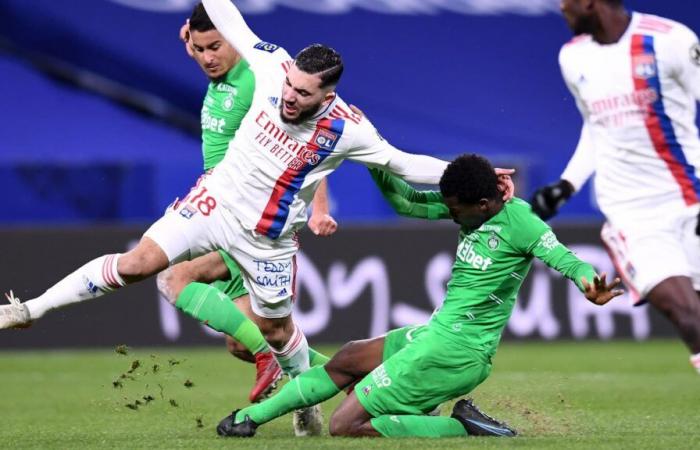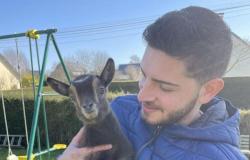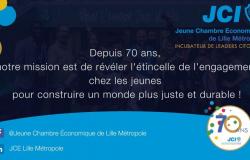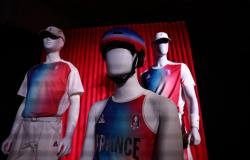The 11th day of Ligue 1 will end on Sunday with the return of the clash between OL and Saint-Étienne, at Groupama Stadium (8:45 p.m.). A derby which seems less fiery and less exposed than in the past, even if it still arouses just as much passion among the supporters.
While we imagined that it was going to turn out to be “crazy”, the impatience to (re)experience a derby between Lyon and Saint-Étienne, 1024 days after the last one played on an evening in January 2022, seems more subdued before the shock of Sunday (8:45 p.m.). The fault lies in a combination of factors: the European Cup in the middle of the week for OL, changes in shareholders and managers on both sides, the sanitization of declarations.
If a form of normalization wins over the main players – players and managers in particular -, as in the adventures of Asterix and Obelix, one village resists indifference: that of the supporters. With proof of its importance: the attendance record of February 25, 2018 (58,069 spectators) risks being beaten!
Changes of eras on both sides
Roland du Forez against Jean-Michel de l'Arbresle. That was before, when the two strong men (Roland Romeyer and Jean-Michel Aulas) occupied the pre-match column almost as much as the players. With each head and legs in their territory from Saint-Etienne for the first and Lyon for the second. And above all the heart firmly anchored in “one’s” history, with the memory of “little stories”.
So when Roland Romeyer remembered one evening that his counterpart Jean-Michel Aulas was looking for a driver for his Formula 1 at the end of the season, and that he saw Rémy Vercoutre arrive in the goals against Stéphane Ruffier then at the top of his art, he does not hesitate to take up the formula by reversing the roles: it is then a question of a “Ferrari” (Ruffier) which he would not exchange for “a 2CV” (Vercoutre). Pass of arms between Roland Romeyer and Jean-Michel Aulas. Without forgetting the Playstation after the 100th derby of September 25, 2010.
Today, the bosses have become bosses, coming from across the Atlantic: John Textor from Florida in the USA for OL, Larry Tanenbaum from Canada for the Greens. OL-ASSE therefore becomes, by caricature, a USA-Canada match, worthy of an Olympic ice hockey final. Very far, in tradition and in kilometers, from a Franco-French match. In 1024 days, things have happened in the shareholding of the two clubs which necessarily reflects on the pre-match atmosphere in a certain “normalized” way because in high places, few managers are imbued with the story – which began on October 28, 1951 – of the 124 previous matches between the two best enemies in French football.
Laurent Prud'homme, the CEO of OL, Mathieu Louis-Jean, the recruitment boss, and Daniel Congré, the new sports coordinator have no Lyon past and will experience their first derby. Ditto 65km away, with President Ivan Gazidis and his right-hand men, Huss Fahmy and Jason Rosenfeld, who had just arrived on June 3. There remain a few pockets of “resistance”, quick to recall the fundamentals whether in the Lyon staff (Sage, Vercoutre, Alioui…) or in Saint-Étienne with the sports director (Perrin) and Hamouma, close to the staff. But what weight do these “local” labels now have? They appear to have been diluted over time, at the heart of a radical transformation of shareholders and managers on both sides.
Fear of the “magnifying glass” effect of social networks
To this lesser impregnation, in the intimacy of the boards of the two clubs of green values on the one hand, red and blue, on the other is added a fear of a good number of actors: that of not seeing their words distorted through social networks. Consequence: many ex-players or ex-managers refuse to talk about memories or feelings from yesterday. Everyone has the same answer: they did it before, but a sentence, taken out of context, was passed through the unhealthy mill of the web. We won't take them twice. Even economic players or amateur clubs have refused “old-fashioned” reporting on stories of chambering for fear of reflections, or even the loss of credibility, and even of markets in the next town. It must be said that the two cities separated by 65km – 72km from stadium to stadium – are both opposed and complementary, rivals and twins.
Enough to feed, depending on the enamored or hostile gaze, the peaks on social networks, between the Saint-Etienne worker (12.5% of the population compared to 5.8% in Lyon) and the Lyon bourgeoisie (25,430 euros of median income between Rhône and Saône against 19,000 in Forez). Some people try their hand at formulas. Witness, Olivier Canal, chef (from Marseille) but based in Lyon for more than 20 years and now boss of the “Bouchons Lyonnais” association. He was questioned by the weekly “Tribune de Lyon” about the disappearance of these typical restaurants in Lyon. Tit for tat, with his verve, he tackles: “Impossible to conceive of Lyon without its traffic jams. It would be sad. It would be… Saint-Étienne. Does that suit you as an answer?” Unfortunately, these formulas are becoming rare. Could Roger Rocher, in 2024, say that Lyon is “the suburb of St-Étienne when it comes to football?” The answer is in the question…
Derby is desperately looking for local players
Only Léo Pétrot (born in Firminy) and Louis Mouton (born in Saint-Étienne) combine the place of birth with the training center while Aïmen Moueffek (born in Vienne in Isère) and Michael Nadé (born in Sarcelles in the Paris region) do not check “only” the “Academy” box. Opposite, the “Lyonnitude” seems a little more marked with players used to derbies among young people and professionals. Alexandre Lacazette, Corentin Tolisso, Maxence Caqueret and Rayan Cherki (Anthony Lopes no longer plays matches but continues to train) have already made history when Georges Mikautadze, trained at OL, a child from the Gerland district, will experience his first professional derby.
But from there to talk about impatience… “I can't talk about impatience, because, already, we play every three days, testifies the Lyon captain, around a historic hat-trick for the last derby on the 8th. November 2015 in Gerland We just came back from Germany, so I wouldn't say it's impatience. It's been a while since I played this kind of derby, so I know it's just necessary. be ready on the day, not before. So I wouldn't say 'impatient' but yeah, excited about playing a derby.”
Same story (neutral), a few hours before in Etrat, at the Greens training center: “Impatient, I don’t know, wonders Léo Petrot. But in any case, when we were in Saint-Étienne , in Ligue 2, with the project of going back to Ligue 1, obviously, we were thinking about it Because when we know that when we go back to Ligue 1, there will be derbies, big matches, and obviously, when we move up. Ligue 1 is about experiencing these kinds of events too. And here we are, we're going to do everything we can to, in any case, enjoy being able to play this kind of match. everything done to go back up, and it's to experience moments like that.”
Very international workforce
It is therefore necessary in a certain way to “evangelize” the rest of the very international workforce on both sides: 4 continents out of 5 represented and 14 different countries in total with on the Lyon side, 14 different nationalities (Brazil, USA, Comoros, Algeria, Angolans, Belgium, England, Senegal, Ivory Coast, Ghana, Serbia, Croatia, Argentina and Algeria) against 8 in Saint-Étienne (Morocco, DRC, New Zealand, Georgia, Belgium, Ghana and Senegal): “We will say that it's more us who explain to them how important it is and what the derby represents, and they are a little surprised to see that there is such importance, testifies Lacazette. So, now. everyone knows about it, everyone knows, but yeah, I think initially they didn't expect so much excitement or for it to be such an important match.”
On the importance, for example, of telling a “detail”: “It's a color that you see, that I don't have at home, and I know that I can use other colors. So yeah, it's is prohibited at home.” Lacazette clearly evokes the color… green, banned in his home. So we're changing things up a bit on the staff side, even if for everyone, it will be a baptism. It will be total for Olivier Dall'Oglio, the coach of the Greens: “We've been talking about it for a little while, explains the Cévennes technician. There has already been the release of the calendar, so that was already this summer I understood that it was a date to check, that's it, and then, often, we have little reminders from the supporters, from the fans too, who remind us of the date. can't forget this meeting, in any case.”
And if they do not know what this derby represents, the supporters recall it in a tradition now well anchored since the supporters no longer make the trip, 2013 for those from Saint-Étienne to Lyon: the passage to the last training and the departure of the bus on Sunday morning towards the regional capital for the Greens fans: “We have to manage to store all the energy that the supporters will be able to give us, imagines Petrot. As we said, they will not be at the stadium to support us, even if we know that they will be behind us, whether in front of their screen or their radio. So we have to be able to capture all this energy, take all this motivation, and have all this motivation. 'We really release it all together on the field afterwards.'
What remains is the real impatience of the fans
1024 days later, the derby returns to where the fans left it, one evening in January 2022 at Groupama Stadium on a penalty from Moussa Dembele (1-0). A hint of impatience? The stadium's attendance record in “football” mode, 58,069 spectators during the 116th clash (1-1 in the end), could be beaten. All tickets have been sold. It remains to establish the final mark. Because this derby was missed by Julien, Gregory, Ludowic and the others: “Yes, because if I'm already stealing these six points a little for OL, testifies Ludowic Clément, unconditional fan. All joking aside, that's all a region, a whole fervor, it is one of the most anticipated matches also in Ligue 1, since it is the real derby in Ligue 1 and there is a real lack and there is an excitement to find this match on Sunday evening.”
While a Lyon-ASSE replaces an OL-Metz, Ol-Lorient or even an OL-Clermont, the other regional derby but without long-term history, everyone is delighted: “When OL and ASSE are facing each other, it's not just about three points at stake”, believes Julien Chamoux, of the 'Rouge et Bleu', who will come down from Courchevel to experience it. “The derby is an issue of regional pride, a match where each club wants to assert itself to claim its supremacy. In the stands, the atmosphere is electric: the songs, the tifos, and sometimes even the provocations create a unique atmosphere, where the intensity is palpable. This match is often called the “hottest” in France because of the emotion and passion it arouses among the supporters.
“It’s a necessary part of a season,” relishes Grégory Cuilleron, restaurateur in Lyon. “I have the impression that it’s like the return of a relative of the family that we would find and that we would have lost sight of. It's nice but we don't really know what it's going to be because we haven't seen it for a long time…” What's more is “face-to-face” because the latest one is there. At 1024 days, it was then in post-Covid mode with a gauge of 5,000 people. And the last one in “real life”, in an almost full stadium, dates back to before Covid 19, March 1, 2020 (52,722 people). An eternity in short, in the land of 124 derbies contested for almost as many anecdotes and little stories in the great history of “Lyon-Sainté”!






